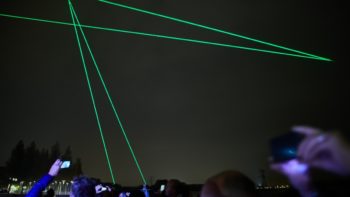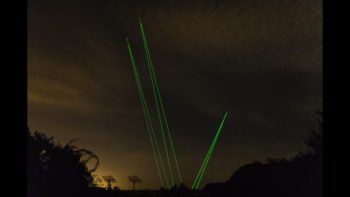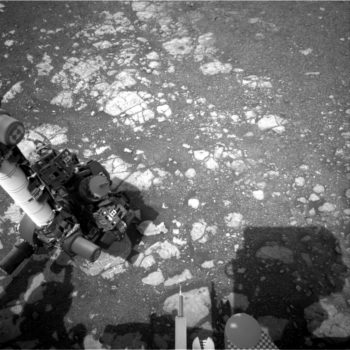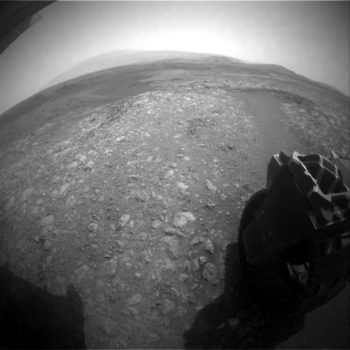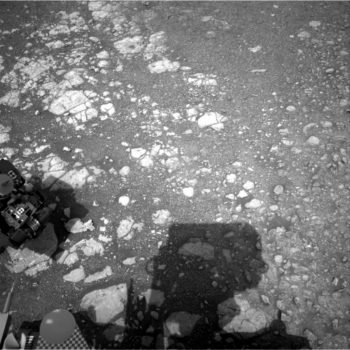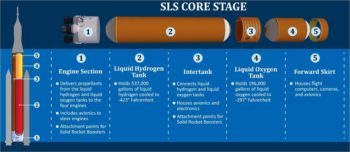Author Archive
“Space waste is the smog of our universe,” explains Dutch artist and innovator Daan Roosegaarde.
Studio Roosegaarde, located in Almere, The Netherlands, has initiated a new, two phase large-scale project: Space Waste Lab.
Viewing the issue
Phase 1 starts with a unique large outdoor Space Waste Lab Performance using LEDs and real-time tracking information to visualize orbital debris circling Earth.
Special designed software and camera technology developed in the last year enables the Space Waste Lab Performance to work, in compliance with strict safety and aviation regulations. The vertical lines of lights highlight space waste crossing above the heads of viewers.
To enhance the sky watching visual experience, the surrounding environment is darkened by shutting down streetlights and commercial signs. An indoor exhibition consists of a real piece of space waste accompanied by an education program.
Phase 2 is a multi-year program to capture space waste and “upcycle” it into sustainable products.
Technologists and artists
The living lab is supported by European Space Agency (ESA) space experts to create a new perspective on space waste.
Explains ESA’s Franco Ongaro, Director of Technology, Engineering and Quality (D/TEC), and Head of ESTEC in Noordwijk, the Netherlands. “I’m a strong believer in cooperation between technologists and artists. We believe in what we do as a service to society, but we are often unable to communicate its worth effectively enough.”
Artists not only communicate vision and feelings to the public, Ongaro says. “This cooperation is all the more important when dealing with issues like space debris, which may one day impact our future, and our ability to draw maximum benefits from space. We need to speak in different ways, to convey not just the dry technological aspects aspect of technology, but the emotions involved in the struggle to preserve this environment for future generations.”
Source material
As noted by the Space Waste Lab, there are more than 29.000 objects larger than 10 centimeters circuiting the Earth. “It is space waste; parts of broken rockets and satellites. This waste can damage our current satellites, with collisions creating more space waste and disturbing our digital communications.”
Artist Roosegaarde adds: “We need to look at space in a better way. What is space waste, how can we fix it, and what is its potential? Can we use space waste as a source material to 3D print houses on the Moon, or use it to create artificial falling stars opposed to polluting fireworks?”
Clean space
The Space Waste Lab is a part of Roosegaarde’s larger vision for “Schoonheid,” a Dutch word meaning both beauty and cleanliness, as in clean space, clean air, clean water, and clean energy.
From early October until mid-January 2018, the Space Waste Lab can be visited.
The live Space Waste Lab Performance can be viewed this year after sunset on November 10, December 7, 8 and January 18, 19 of next year.
For more information on this innovative look at orbital debris, go to:
https://www.studioroosegaarde.net/project/spacewaste-lab
Go to this informative video at:
https://www.facebook.com/DaanRoosegaarde/videos/1074871129342531/?t=39

Curiosity Front Hazcam Left A image acquired back on Sol 2199, October 13, 2018.
Credit: NASA/JPL-Caltech
Now in Sol 2205, word about NASA’s balky Curiosity Mars robot is that rover science is back…well, sort of.
Sarah Lamm, a planetary geologist at the Los Alamos National Laboratory in New Mexico reports that the rover team is excited that science operations are starting to resume.
The last images from the Mars machinery were taken on October 13, 2018.
Anomaly work continues
“The real fright was when Curiosity had an anomaly on Sol 2172 which affected its memory,” Lamm says. “Since then, the engineering team has continued to diagnose the anomaly and plan the recovery, including taking the first images with the A-side engineering cameras that haven’t been used since 2013! Thanks to our hard-working engineers, Curiosity is ready for limited science operations while the anomaly work continues.”
Lamm adds that Curiosity has been at the (sadly) unsuccessful “Inverness” drill site since the anomaly. “Curiosity is still exploring the gray Jura member on Vera Rubin Ridge.”
Data collecting
The uplink plan for Sol 2204 called for active and passive use of the robot’s Radiation Assessment Detector (RAD), the Dynamic Albedo of Neutrons (DAN) and the Rover Environmental Monitoring Station (REMS).
RAD detects high-energy radiation on the Martian surface.
“RAD’s data will help shape future human mission to Mars by letting us know how much shielding from radiation future Mars astronauts will need to protect them,” Lamm explains. “REMS is Curiosity’s weather station. REMS can measure pressure, humidity, ultraviolet radiation, and temperature. DAN (Dynamic Albedo of Neutrons) detects neutrons that be used to measure the amount of hydrogen and other elements in the subsurface.”

Experimental rocket engine to collect beamed microwave energy to heat propellants to plasma temperatures.
Credit: Penn State
The use of beamed microwave energy to launch space vehicles off the surface of Earth is getting a fresh look.
Penn State College of Engineering has been awarded funds to develop and use a facility over three years to study the concept. The Air Force Office of Scientific Research (AFOSR) is backing the work.
Two awards
According to a Penn State press statement: The funding consists of two separate awards, with the first being $396,865 provided by the Defense University Research Instrumentation Program, which funds large-scale equipment acquisition by universities. This award will be used to acquire a five-foot diameter by eight-foot-long high-vacuum chamber to simulate both high altitudes and the space environment.
The funding also provides for the acquisition of a high-power microwave source and related microwave and optical diagnostic equipment.
The second award of $426,913 from AFOSR is to utilize the facility to examine the feasibility of beaming microwave power to a space vehicle, where it is focused to heat either an on-board propellant or ingested surrounding air to create a plasma with temperatures higher than can be achieved with current chemical propulsion methods.
Experimental site
“Since the microwave source is located on the ground and not on the space vehicle, it is powered by the commercial electrical grid, allowing a large amount of energy to be transmitted to the space vehicle without any weight penalty for the vehicle,” the Penn State statement explains.
Experiments will also be conducted at the Air Force Research Laboratory in Albuquerque, New Mexico, where a multimillion-dollar 100-kilowatt, 95-gigahertz microwave source is located.
“If this concept proves viable, it has the potential to drastically reduce the cost of placing spacecraft into Earth’s orbit, something which has both governmental and commercial applications,” said Michael Micci, professor of aerospace engineering at Penn State.
Human-made moons to reflect sunlight to Earth are on the table according to a Chinese researcher.
A trio of the artificial moons would be lofted in 2022, placed in space to divide the 360-degree orbital plane, thereby illuminating an area on the planet 24/7.
Shine a light on me
The idea is espoused by Wu Chunfeng, head of Tianfu New District System Science Research Institute in Chengdu, Southwest China’s Sichuan province, and advanced in China’s Science and Technology Daily.
Wu’s vision is that reflected sunlight can cover an area of 3,600 square kilometers to 6,400 square kilometers, and the illumination intensity is expected to be eight times of natural moonlight.
Mock moon
In a story carried by Ecns.cn, the official English-language website of China News Service, Wu said the mock Moon is expected to be placed in an orbit within 310 miles (500 kilometers) from Earth.
The Ecns.cn posting explains that the moonlight can be adjusted in light intensity and the area on Earth illuminated can be controlled within scores of meters.
“Using man-made moon to illuminate an area 50 square kilometers can save 1.2 billion yuan of electric charge,” Wu explains in the article. “It can also illuminate blackout areas when natural disasters such as earthquake happen.”
Next July’s celebration of the 50th anniversary of the Apollo 11 Moon landing in July 1969 — a venture that cost U.S. taxpayers $25 billion in then-year dollars — is now a four-coin program: a curved $5 gold coin, a curved $1 silver coin, a curved half-dollar clad coin, and a curved 5 ounce $1 silver proof coin.
That’s the word from the U.S. Mint.
As required by the Public Law, the Mint invited American artists to design a common front of the coin image that is emblematic of the United States Space Program leading up to the first manned Moon landing. The Secretary of the Treasury selected the design from a juried competition.
Steps to the moon
Gary Cooper of Belfast, Maine created the winning design in the Apollo 11 Commemorative Coin Design Competition. The “obverse” design was selected from entries in a juried competition as required by the authorizing legislation, Public Law 114-282.
The winning design by features the inscriptions “MERCURY,” “GEMINI,” and “APOLLO”— separated by phases of the Moon—and a footprint on the lunar surface. The design represents the efforts of the United States space program leading up to the first manned Moon landing.
Iconic reflection
The “reverse” design is by Mint Sculptor-Engraver Phebe Hemphill. It features a representation of a close-up of the iconic ‘Buzz Aldrin on the Moon’ photograph taken July 20, 1969, showing just the visor and part of the helmet of astronaut Buzz Aldrin. The reflection in Aldrin’s helmet includes astronaut Neil Armstrong, the United States flag, and the lunar lander.
Prices for the coins include surcharges of $35 for each gold coin, $10 for each silver coin, $5 for each half dollar clad coin and $50 for each five ounce proof silver dollar coin, which the law authorizes to be paid as follows: one-half to the Smithsonian Institution’s National Air and Space Museum’s “Destination Moon” exhibit, one-quarter to the Astronauts Memorial Foundation, and one-quarter to the Astronaut Scholarship Foundation.
For more information, go to:
Following almost a month of not relaying imagery, NASA’s Curiosity rover is back on line, delivering a limited number of photos from Vera Rubin Ridge.
The robot is now in Sol 2200. Due to a rover glitch no imagery had been relayed back to Earth since Sol 2172 on September 15th.
As of this posting, Curiosity’s Chemistry & Camera (ChemCam), Mars Descent Imager (MARDI), Mars Hand Lens Imager (MAHLI) and the Mast Camera (Mastcam) have not, as yet, produced imagery.

From RAND report: The U.S.-China Military Scorecard: Forces, Geography, and the Evolving Balance of Power 1996–2017.
Space war games are being played out by the Air Force Space Command by way of the 12th Schriever Wargame at Maxwell Air Force Base, Alabama.
Initiated on October 11, 2018, the Schriever Wargame scenario, set in the year 2028, will explore critical space issues and investigate the integration activities of multiple agencies associated with space systems and services.
The Schriever Wargame 2018 (SW 18) will include international partners from Australia, Canada, France, Germany, Japan, New Zealand, and the United Kingdom.
Objectives
The objectives of the Wargame are centered on:
1) Examining how international partner capabilities can deter an adversary from extending or escalating a conflict into space;
2) Gaining insight into resiliency, deterrence, and warfighting through international partner synchronization of space and cyberspace operations;
3) Exploring various combined command and control (C2) frameworks to employ and defend air, space and cyberspace capabilities in support of global and geographic / regional operations;
4) Identifying the strategic and operational contributions of space and cyberspace in a multi-domain conflict; and
5) Exploring partnerships framed by a whole of governments approach (International, Civil, Commercial) to combined space and cyberspace operations.
Scenarios
According to an Air Force statement, the 18 scenario Schriever Wargame depicts a notional peer space and cyberspace competitor seeking to achieve strategic goals by exploiting those domains.
It will include a global scenario with the focus of effort towards the U.S. Indo-Pacific Command (USINDOPACOM) Area of Responsibility. The scenario will also include a full spectrum of threats across diverse operating environments to challenge civilian and military leaders, planners and space system operators, as well as the capabilities they employ.
U.S/international partners
The Schriever Wargame Team to carry out the gamming learning is done on behalf of Air Force Space Command, headquartered in Colorado Springs, Colorado.
Roughly 350 military and civilian experts from more than 27 commands and agencies around the country, as well as seven international partners, will participate in the Wargame.
U.S. commands and agencies participating in Schriever Wargame 2018 include: Air Force Space Command, Army Space and Missile Defense Command, Naval Fleet Cyber Command, the National Reconnaissance Office, Executive Agent for Space Staff, Air Combat Command, Office of the Secretary of Defense, USINDOPACOM, U.S. Strategic Command, U.S. Special Operations Command, U.S. Northern Command, the Intelligence Community, National Aeronautics and Space Administration, Office of Homeland Security, Department of Transportation, Department of State and Department of Commerce.

The U.S. Air Force’s X-37B Orbital Test Vehicle 4 is seen after landing at NASA ‘s Kennedy Space Center Shuttle Landing Facility in Florida on May 7, 2017.
Credit: U.S. Air Force courtesy photo
The hush-hush mission of a U.S. Air Force X-37B mini-space plane has winged past 400 days of flight.
This mission – tagged as Orbital Test Vehicle (OTV-5) — was rocketed into Earth orbit on September 7, 2017 atop a SpaceX Falcon 9 booster from Launch Complex 39A at NASA’s Kennedy Space Center in Florida.
The robotic winged drone is carrying out secretive duties during the program’s fifth flight.
Flight duration
Each X-37B/OTV mission has set a new flight-duration record for the program:
OTV-1 began April 22, 2010, and concluded on Dec. 3, 2010, after 224 days in orbit.
OTV-2 began March 5, 2011, and concluded on June 16, 2012, after 468 days on orbit.
OTV-3 chalked up nearly 675 days in orbit before finally coming down on Oct. 17, 2014.
OTV-4 conducted on-orbit experiments for 718 days during its mission, extending the total number of days spent in space for the OTV program at that point to 2,085 days.
What’s up?
On this latest clandestine mission of the space plane, all that’s known according to Air Force officials is that one payload flying on OTV-5 is the Advanced Structurally Embedded Thermal Spreader, or ASETS-II.
Developed by the U.S. Air Force Research Laboratory (AFRL), this cargo is testing experimental electronics and oscillating heat pipes for long duration stints in the space environment. According to AFRL, the three primary science objectives are to measure the initial on-orbit thermal performance, to measure long duration thermal performance, and to assess any lifetime degradation.

The X-37B Orbital Test Vehicle mission 4 (OTV-4), the Air Force’s unmanned, reusable space plane, landed at NASA’s Kennedy Space Center Shuttle Landing Facility May 7, 2017.
Credit: USAF
Landing site
When the space plane will land is unknown. The last Air Force’s X-37B Orbital Test Vehicle mission touched down at NASA’s Kennedy Space Center Shuttle Landing Facility May 7, 2017 – a first for the program. All prior missions had ended with a tarmac touchdown at Vandenberg Air Force Base in California.
Several website postings say that the sixth mission, X-37B OTV-6, is planned for 2019 on a United Launch Alliance Atlas-5(501) rocket. Launch would be from Cape Canaveral Air Force Station’s Space Launch Complex-41.
Reusable vehicles
The classified X-37B program “fleet” consists of two known reusable vehicles, both of which were built by Boeing. The X-37B Orbital Test Vehicle was built at several Boeing locations in Southern California, including Huntington Beach, Seal Beach and El Segundo. The program transitioned to the U.S. Air Force in 2004 after earlier funded research efforts by Boeing, NASA and the Defense Advanced Research Projects Agency.
Looking like a miniature version of NASA’s now-retired space shuttle orbiter, the military space plane is 29 feet (8.8 meters) long and 9.6 feet (2.9 m) tall, with a wingspan of nearly 15 feet (4.6 m). The X-37B space plane has a payload bay of 7 feet (2.1 meters) by 4 feet (1.2 meters), a bay that can be outfitted with a robotic arm. X-37B has a launch weight of 11,000 lbs. (4,990 kilograms) and is powered on orbit by gallium-arsenide solar cells with lithium-ion batteries.

Back to hangar for another flight day. U.S. Air Force X-37B/OTV-4 is rolled into facility after its May 7 landing at Kennedy Space Center.
Credit: Michael Martin/SAF
On-orbit duties
The missions of the X-37B space planes are carried out under the auspices of the Air Force Rapid Capabilities Office, and mission control for OTV flights are handled by the 3rd Space Experimentation Squadron at Schriever Air Force Base in Colorado. This squadron oversees operations of the X-37B Orbital Test Vehicle.
This Schriever Air Force Base unit is billed as the Air Force Space Command’s premier organization for space-based demonstrations, pathfinders and experiment testing, gathering information on objects high above Earth and carrying out other intelligence-gathering duties.
And that may be a signal as to what the robotic craft is doing — both looking down at Earth and upward.
Repeating ground tracks
Ted Molczan, a Toronto-based satellite analyst, told Inside Outer Space that OTV 5’s orbit at the start of August was about 197 miles (317 kilometers) high, inclined 54.5 deg to the equator. Its ground track repeated nearly every five days, after 78 revolutions.
“Maneuvers on August 18 and 21 raised its orbit by 45 miles (74 kilometers) which caused its ground track to exactly repeat every three days, after 46 revolutions. It was still in that orbit when last observed, on September 8, by Alberto Rango, from Rome, Italy,” Molczan added.
“Repeating ground tracks are very common,” Molczan said, “especially for spacecraft that observe the Earth. I do not know why OTV has repeating ground tracks,” he concluded.
Numerous boulders, many rocks, no dust – that’s the report from operators of the MASCOT lander deployed from its mother probe, the Japan Aerospace Exploration Agency’s Hayabusa2 mission to the near-Earth asteroid Ryugu.
MASCOT is space shorthand for Mobile Asteroid Surface Scout.
Never before in the history of space has a body of the Solar System been explored in this way.
Ryugu is a C-type asteroid – a carbon-rich representative of the oldest bodies of the four-and-a-half-billion year-old Solar System.
Gentle impact
On October 3, after six minutes of free fall, a gentle impact on the asteroid and then 11 minutes of rebounding until coming to rest – that’s the journey of MASCOT.
Some 17 hours of scientific exploration followed this first ‘stroll’ on the space rock.
The lander was commanded and controlled from the MASCOT Control Centre at the German Aerospace Center (Deutsches Zentrum für Luft- und Raumfahrt; DLR) site in Cologne in the presence of scientific teams from Germany, France and Japan.
The German-French lander MASCOT on board Hayabusa2 was developed by the German Aerospace Center (Deutsches Zentrum für Luft- und Raumfahrt; DLR) and built in close cooperation with the French space agency CNES (Centre National d’Etudes Spatiales).

Photo (right) taken after first contact with asteroid.
Credit: JAXA/U Tokyo/Kochi U/Rikkyo U/Nagoya U/Chiba Inst Tech/Jeiji U/U Aizu/AIST (links); MASCOT/DLR/JAXA (rechts).
Pathway charted
It has now been possible to precisely trace MASCOT’s path on Ryugu’s surface on the basis of image data from the Japanese Hayabusa2 space probe and the lander’s images and data.
On the surface, MASCOT moved through the activation of a tungsten swing arm accelerated and decelerated by a motor. This made it possible for MASCOT to be repositioned to the ‘correct’ side or even perform hops across the asteroid’s surface.
During the mission, the team named MASCOT’s landing site (MA-9) ‘Alice’s Wonderland’, after the book by Lewis Carroll (1832-1898).
Jump and Mini-move
After the first impact, MASCOT smoothly bounced off a large block, touched the ground about eight times, and then found itself in a resting position unfavorable for taking on-the-spot measurements.

The MASCOT battery powered up after four years on standby during its trip from Earth to the asteroid.
Credit: Saft
After commanding and executing a specially prepared correction maneuver, MASCOT came to a second halt. The exact location of this second position is still being determined.
There, the lander completed detailed measurements during one asteroid day and night. This was followed by a small ‘mini-move’ to provide the MicrOmega spectrometer with even better conditions for measuring the composition of the asteroid material.
Finally, MASCOT was set in motion one last time for a bigger jump. At the last location it carried out some more measurements before the third night on the asteroid began, and contact with Hayabusa2 was lost as the spaceship had moved out of line of sight. Its onboard battery depleted, MASCOT’s 17 hours and 7 minutes on Ryugu was over.
Note: Story based on DLR press statement.
Originally, the first uncrewed mission of the combined Space Launch System (SLS)/Orion system known as Exploration Mission-1 (EM-1) had a launch readiness date of December 2017,
The first crewed mission of the system known as Exploration Mission-2 (EM-2) was projected to launch in mid-2021.
Launch slips
However, a new NASA Office of Inspector General (OIG) report has found, due to continued production delays with the SLS Core Stage and upcoming critical testing and integration activities, current NASA schedules indicate launch dates of mid-2020 and mid-2022, respectively.
With $5.3 billion expended as of August 2018 out of $6.2 billion allocated for the Boeing Stages contract, NASA expects Boeing to reach the contract’s value by early 2019—nearly 3 years before the contract is supposed to end—without final delivery of a single Core Stage or EUS.
Wanted: increase in funding
As a result, the OIG report explains that the SLS Program will require a major increase in funding and renegotiation of the Boeing Stages contract to meet current launch readiness dates for the two Core Stages and EUS.
The OIG report concludes that, in support of NASA’s goal of manned space flight beyond low Earth orbit, the Agency has been working since 2010 to develop a heavy-lift rocket. “As of August 2018, NASA has spent $11.9 billion on the SLS, but will require significant additional funding to complete the first Core Stage—more than 3 years later than initially planned and at double the anticipated cost.”
Boeing: poor performance
“In addition to Boeing’s poor performance, we found a number of unacceptable procurement practices by NASA officials at Marshall that added to contract cost and schedule issues. These practices included not tracking the costs of specific deliverables for each Core Stage and EUS, contracting officers exceeding their warrants, paying significant award fees despite contractor poor performance, and the lack of an approved plan for future Core Stage production. We question nearly $64 million in award fees provided to Boeing since 2012 for the “very good” and “excellent” performance ratings it received while the SLS Program was experiencing substantial cost increases, technical issues, and schedule delays. Without significant corrective action, NASA’s efforts to build its first two Core Stages and the EUS will cost significantly more and take considerably longer than anticipated.”

This artist’s rendering shows a NASA concept of a Europa lander mission.
Credit: NASA/JPL-Caltech/M. Carroll
Europa mission jeopardized
Given that NASA officials estimate needing 52 months of lead time from issuing a contract to delivery, the OIG reports that “the earliest a third Core Stage can be produced is 2023, jeopardizing planned launch dates for future missions that require the rocket, including EM-2 and potentially a science mission to Europa, one of Jupiter’s moons, in 2022.”
Go to this October 10, 2018 report – “NASA’s Management of the Space Launch System Stages Contract” – at:
